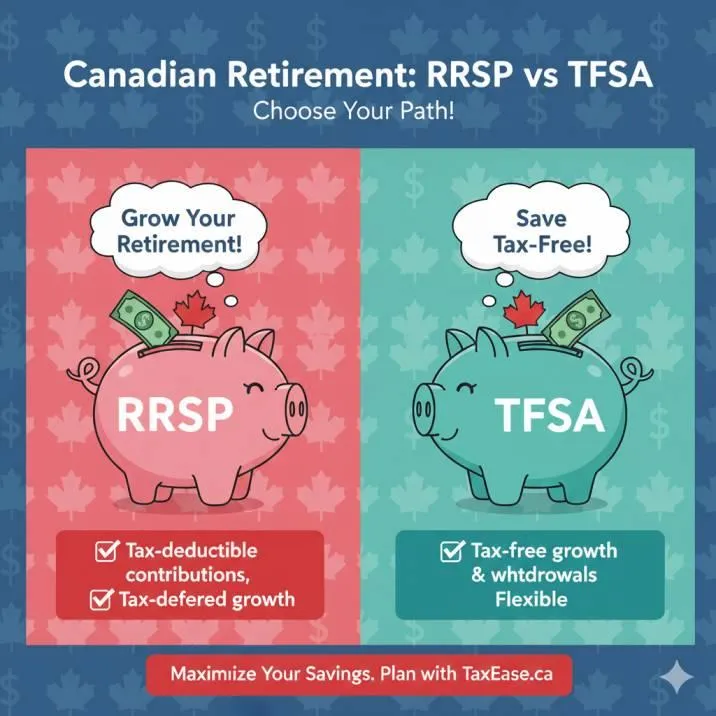Learning Center


RRSP vs. TFSA: Which Is Right for Your Retirement Savings?
The Retirement Dilemma Every Canadian Faces
When it comes to planning your future, one question looms large: RRSP vs TFSA—which is better for retirement in Canada?
Both accounts offer powerful tax advantages, but they work differently depending on your income, lifestyle, and retirement plans. Choosing the right one can mean the difference between struggling in retirement and living comfortably.
At Taxease, we help Canadians navigate these decisions every tax season. In this guide, we’ll compare the Registered Retirement Savings Plan (RRSP) and the Tax-Free Savings Account (TFSA) in detail, so you can make informed choices to maximize your retirement savings in Canada.

RRSP Basics – Why High-Income Earners Prioritize It
The Registered Retirement Savings Plan (RRSP) is designed for Canadians looking to reduce taxable income today while saving for tomorrow.
Key Features of RRSPs
Tax Deduction: Contributions reduce your taxable income immediately (a major benefit if you’re in a high tax bracket).
Tax-Deferred Growth: Investments grow tax-sheltered until withdrawal.
Contribution Limit (2024): 18% of earned income, up to $31,560.
👉 For high-income earners, prioritizing RRSP contributions means getting significant tax refunds now, which can even be reinvested in a TFSA for a double advantage.

TFSA Basics – Why Low-Income Canadians Love It
The Tax-Free Savings Account (TFSA) shines for flexibility and tax-free withdrawals.
Key Features of TFSAs
No Tax Deduction on Contribution: Deposits don’t lower taxable income upfront.
Tax-Free Growth & Withdrawals: Every dollar earned (interest, dividends, capital gains) is yours to keep—completely tax-free.
Contribution Room (2024): $7,000 for the year, with a total lifetime limit of $95,000 if you’ve been eligible since 2009.
👉 TFSAs are ideal for low-income earners who don’t benefit much from tax deductions today but want tax-free money in retirement.

Side-by-Side Comparison – RRSP vs TFSA Canada Retirement
Here’s how they stack up:



Strategic Scenarios – Which Account Wins?
Young Canadians in Low Tax Brackets
For students or entry-level workers, the TFSA is better. RRSP deductions won’t help much when your income is low, but tax-free growth in a TFSA will benefit long-term.
High-Income Professionals
If you’re earning six figures, RRSP contributions reduce taxable income today, saving you thousands. The RRSP refund reinvested into your TFSA creates a powerful one-two punch.
Planning to Buy a First Home
RRSPs allow you to withdraw up to $35,000 under the Home Buyers’ Plan tax-free (repayable), while TFSAs let you withdraw without repayment. The best strategy? Use both—RRSP for the program, TFSA as a backup.
Retirement & OAS Clawback Concerns
Withdrawals from RRSPs (or RRIFs) count as taxable income, which can trigger the OAS clawback. TFSA withdrawals don’t affect eligibility, making them the safer account for retirement income planning.

Tax Advantage Investing in Canada – Maximizing Growth
Choosing between RRSP tax deduction vs TFSA tax-free withdrawals isn’t just about income—it’s also about investment strategy.
High-Growth Stocks → TFSA: Gains remain tax-free for life.
Income-Producing Assets → RRSP: Dividends and interest are sheltered until retirement.
Balanced Approach: Use both accounts to diversify tax risk.
👉 Example: If you invest $50,000 in high-growth tech stocks inside a TFSA and it triples, the entire $100,000+ gain is yours tax-free. In an RRSP, withdrawals would eventually be taxed.

Practical Tips – How Canadians Maximize Retirement Savings
Know Your Marginal Tax Rate: If it’s high now, lean RRSP; if low, lean TFSA.
Track Contribution Room: Over-contributions face penalties (CRA keeps records).
Reinvest Refunds: Always put your RRSP tax refund into a TFSA or back into the RRSP.
Use Spousal RRSPs: Great for couples where one partner earns significantly more.
Plan Withdrawals: Strategize to avoid higher tax brackets in retirement.

TFSA or RRSP? The Answer May Be Both
So, TFSA or RRSP—which is better for retirement in Canada? The truth is: it depends.
If you’re young or in a low-income bracket → TFSA first.
If you’re a high-income earner → RRSP first, then use the refund to fund your TFSA.
For most Canadians, the best approach is a balanced strategy that combines both.
At Taxease, our experts help you align your tax and investment strategy so you don’t just save for retirement—you retire with peace of mind and low taxable income.
👉Ready to maximize your RRSP and TFSA strategy? Book a consultation with Taxease today and let’s build your retirement plan together.
TaxEase.ca is a Canadian tax preparation and accounting firm serving individual and corporate clients Canada-wide.
Useful Links
©2025 . All Rights Reserved.
